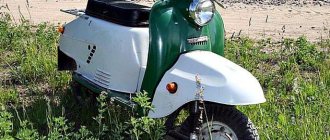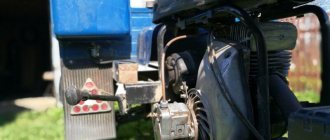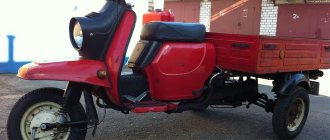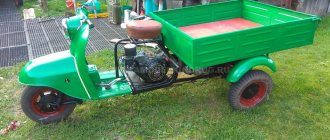The Ant scooter was produced at the Tula Machine-Building Plant from 1959 to 1995. Its modification, or as they say now, restyling, was carried out in 1983 and the updated version received the designation Ant 2M 01. The longevity of this unusual three-wheeled vehicle was brought, first of all, by positive qualities, among which it is necessary to highlight:
- versatility;
- affordable price;
- simple repair;
- compactness;
- maneuverability.
The TMZ Ant scooter was the first cargo model of motorcycle equipment mass-produced in the USSR. The presence of a cargo platform allowing it to transport 250 kg of cargo at a speed of 60 km/h made the Ant very popular. It is enough to note the areas in which it was used:
- Transportation within the city, including small batches of products for restaurants, cafes and canteens.
- In-plant transportation, when small batches of certain components were moved between production departments.
- Transportation of small volumes of building materials, especially in urban environments.
- Carrying out transportation inside enclosed spaces, primarily for agricultural purposes (greenhouses, poultry farms, livestock farms).
For various modifications of the TMZ Ant scooter, four body options were used:
- open;
- open reduced (installed on the cargo-passenger version);
- awning;
- van.
The most significant drawback is the lack of any comfort for the driver, who was forced to spend almost the entire working day behind the wheel of a scooter. It was especially difficult to work in winter, since, unlike two-wheeled mopeds, scooters and motorcycles, the Ant cargo scooter was used at state-owned enterprises even in winter.
Motor scooter Ant: adjusting the clutch with your own hands
Like any other equipment, the “Ant” scooter can break down and need repair. But thanks to its structure, repairs can be done independently.
The “Ant” clutch is one of the weak points of the scooter, which needs frequent adjustment and cable replacement.
Carefully observe the clutch, as problems can be divided into 2 main causes:
- The clutch drives. In this case, problems are possible:
- the cable has become unraveled, rusted or bent;
- adjusting nuts are too tight;
- large free play of the lever;
- crooked discs.
- The clutch is slipping. Possible reasons:
- The cable has become unraveled, rusted or bent;
- The adjusting nuts need additional tightening;
- There is no free play of the lever;
- Crooked discs.
In any case, if there are problems with the clutch, you need to check the condition of the cable :
- If upon visual inspection it is not bent or damaged, then it is worth lubricating it with oil. To do this, you will need a mixture of gasoline and oil, diluted one to one. Using a syringe, pour this mixture into the casing.
- If the cable is bent or damaged, then there is only one way out - replace it with a new one.
If necessary, we proceed to check and adjust the clutch nuts.
Instructions for adjusting the clutch nuts:
- Unscrew the locknut of the adjusting screw;
- Using a screwdriver, slightly unscrew the adjusting screw;
- We twist it back until you feel that it has rested against something;
- We tighten the locknut;
- We look for the clutch lever on the steering wheel - press it, at the same time watch the pressure plate. It should not come off lopsided. If it comes off, then use a screwdriver to adjust the corresponding nuts until the disk moves perpendicular to exactly the axis of the basket
- On the engine, we look for the clutch lever free play adjustment bolt - tighten it so that the free play is 5-10mm.
Technical characteristics of "Ant"
Dimensions:
- length - 2880 mm;
- width - 1250 mm;
- height - 1075 mm;
- ground clearance - 115 mm.
Body dimensions:
- length - 1250 mm;
- width - 1130 mm;
- loading height - 600 mm.
Weight - 240 kg. Load capacity - 250 kg. Maximum speed – 60 km/h
Be sure to read: Czech mower
Engine - carburetor, 2-stroke:
- volume - 199 cm³;
- power - 11 l. With.
Fuel consumption - up to 10-12 l / 100 km. Gas tank volume - 10 l. Gearbox - manual, 4-speed. Brakes - drum.
Pros and cons of the Ant scooter
Despite very modest technical advantages, the device has a couple more trump cards.
- The engine is turned on using a starter, just like in cars. All thanks to the built-in kick and dyno starters;
- It is lighter than a motorcycle equipped with a sidecar and more spacious;
- Very maneuverable. The turning radius is only 3.5 meters, which allows you to maneuver in narrow rural streets or in old areas of cities;
- Nice price. It varies from 30 to 40 thousand rubles; The price-quality ratio for the Ant scooter is very decent;
- Easy to repair. Even a beginner can figure out the structure of this Soviet scooter without watching training videos, and you can get to all the parts by simply turning the unit on its side. Such accessibility allows repairs to be carried out anywhere and at any time, which, you see, is irreplaceable.
But, of course, cargo scooters also have additional disadvantages:
- Frequent breakdowns. Despite the Soviet assembly “for centuries”, not every foreign tricycle can withstand 25 years of service. The situation is further complicated by the fact that new parts are no longer available in Russia, and in China the spare parts are not of the highest quality.
- Poor cross-country ability on sticky soil. Due to its impressive weight, even without cargo, the Ant may simply not get out of the sand or mud on country roads. There is no point in talking about uncleared snow at all.
- Impossibility of tuning. No one does cosmetic repairs to such equipment; at most, they change the main unit when the original one cannot be repaired. But if you really want to, you can take on the tuning of the “Ant” scooter yourself.
Despite its shortcomings, such a cargo scooter is an excellent helper at a summer cottage or in a rural area, and if you choose the Ant motorcycle, you won’t go wrong.
Peculiarities
The Ant cargo scooter is quite easy to maintain. If it breaks, you can turn it on its side and make repairs or replace parts. However, it cannot be called economical, since a 2-liter single-cylinder engine consumes as much as 8 liters per 100 kilometers , and after wear of the piston system it is 10 liters. However, at that time the cost of gasoline was low, so there were no problems with operation.
The simplicity of the motorcycle’s structure does not require any special knowledge of a mechanic, because even to remove the tire there is no need to re-mount it. Simply unscrew the bolts located in a circle. These types of features of the moped allow repairs to be made anywhere, without special equipment. Which is very convenient, because it’s no secret how often Soviet equipment breaks down. However, in case of serious engine and chassis breakdowns, which occur quite often, the knowledge of a mechanic is sometimes simply necessary.
If necessary, you could choose a moped with the most suitable configuration. Thus, models with an additional seat for a passenger and models with a closed body were released.
The Ant scooter currently has many analogues in Asian countries. Road congestion in Asia has made the cargo moped one of the most popular models for hard workers. It allows you to easily navigate narrow alleys and significantly reduces travel time. The Chinese analogue and the original Ant scooter, although they do not have significant differences in appearance, are strikingly different in quality.
Engines 157QMJ
In addition to the very popular model - the 139QMB engines - Hongling Corporation produces other versions of power units, one of which is the 157QMJ. It is installed on expensive scooter models of famous brands. In terms of its technical parameters and indicators of functionality and reliability, this version is a complete analogue of 139QMB. In addition, the design features of the model are strongly reminiscent of other mass-produced Japanese engines.
The advantage of the 157QMJ is its increased service life - about 25 thousand kilometers. The engine boasts powerful dynamics and a high top speed. However, it also has its downside - the price is too high compared to previous versions of the engines.
Maintenance and repair
Due to its low weight, this moped, if necessary, can be “put on its side” even alone. Also, given that Ant disc wheels consist of 2 halves bolted together, replacing a damaged tire is quite simple. To connect the tube and the spare tire, it is necessary to separate the parts of the removed wheel.
Motor scooter repair Ant
Tools
In order to properly repair a Soviet moped, you will need the following tools:
- double-sided wrenches (set), 4-22 millimeters;
- screwdrivers - 3 pcs. (large, medium, small);
- hammers, 2 pcs. (100 and 300 grams);
- combination forceps;
- wooden stick;
- wire cutters;
- pliers;
- socket wrenches (4 pcs.);
- velvet files - 2 pcs. (flat).
Diagnostics
The Ant scooter must undergo regular maintenance. This is necessary for two reasons:
- This will improve performance characteristics and thereby make the model more reliable and durable.
- Timely diagnostics will allow the owner of such a rare motor vehicle as the Ant scooter to avoid an accident.
Unfortunately, not every owner of such a Soviet rarity as the Ant motor scooter regularly visits the service. Often, completely “dead” equipment is received for repair.
Scooter maintenance
Professional servicing of Ant is a series of operations through which the scooter remains in impeccable condition. Scooter Ant needs:
- daily cleaning;
- washing;
- lubrication;
- oil change;
- adjusting brakes and breaker;
- changing used tires.
If maintenance is not regular, the Ant scooter will require major repairs, which implies a serious financial and time investment.
Fuel system
The power system consists of a fuel tank, carburetor and air filter
Fuel supply by gravity, supply control by mechanical fuel tap
The latest scooters were equipped with a more advanced K-65G carburetor. In general, the carburetor is very good, if only because it has two systems that make starting easier in cold weather: a manual enricher on the steering wheel and a float suppressor. All these systems together ensure reliable engine starting in any frost
To increase low-end thrust, a reed valve was added to the engine design. The valve is installed in the cylinder and blocks the reverse emission of fuel from the crank chamber
The cylinder is purged with three channels. Three-channel purge ensures better cylinder filling
The cylinder head has a displacer. The displacer itself is useless, but in combination with a three-channel purge and a reed valve it significantly adds traction at the bottom
Analogues - engine 1P39QMB
Chinese developers have created an analogue of the Japanese 139QMB engine - a motor labeled 1P39QMB, which in appearance completely replicates the original. Despite all the similarities, you can still find differences: the valve clearances on the 1P39QMB are not adjustable. The situation is similar with the carburetor: before direct operation it requires thorough cleaning and correct adjustment. Chinese copies of 139QMB engines, of course, cope with their task, but their main purpose was to reduce the final cost of motor vehicles. Budget versions of scooters are equipped with exactly the same versions of engines that are good only for short trips at low speeds.
Before starting operation, be sure to carry out a full run-in of the 1P39QMB engine. The optimal operating mode of the engine begins only after 2 thousand kilometers, but after 10 thousand kilometers all its technical characteristics drop, and it loses dynamics and power.
A short summary
So, the Ant moped is a real Soviet classic . At the time of release, this vehicle was one of the best options in terms of price/quality. And now such a bike demonstrates good technical parameters. But, since the motorcycle has not been modernized for a long time, its fuel consumption is very high.
Thus, maintaining such a workhorse will cost a lot of money, so the bike is more suitable for lovers of rare models than for people who are looking for transport for daily use.
Video review of the Ant scooter:
Removing and checking the piston (CPG)
Remove the cylinder head (cylinder head).
The cylinder head gasket held up well, as evidenced by the absence of oil leaks.
In the upper part of the cylinder opposite the exhaust window, we feel the groove with our finger. If it feels a clearly perceptible so-called “wave”, “step”, that is, a drop, then such a cylinder is no longer subject to further use. It needs to be either bored to repair size or bought a new one.
The wear can be easily felt in the place where the piston rings do not reach the end of the cylinder. In the place where the piston rings do not work, the nominal factory size is maintained, but in the place where they work, the metal wears out. That is why a transition is formed at the boundary of these two sections, which is larger the greater the wear of the cylinder.
In my case, as expected, the wear was clearly palpable and the cylinder mirror was covered in nicks and scratches.
A bunch of hay that blocked the flow of cooling air, in my opinion, did not increase the efficiency of the cooling system... How can you even drive like this???
The piston turned out to be burst and, moreover, according to the good old collective farm tradition, it was treated with sandpaper. As indicated by numerous risks on its surface.
After removing the clutch cover and removing the kickstarter shaft, the reason for the freezing of the winding lever was found - the return spring had burst in half.
The motor chain turned out to be stretched, but not critically.
Engine tuning
The first thing they try to change when tuning the 139QMB engine is the cubic capacity. For this purpose, the standard piston system is replaced with an 82cc one. At the same time, a new cylinder head with enlarged valves is installed. The piston system changes along with the camshaft, since a larger amount of fuel-air mixture is required for its correct operation. A new camshaft will help increase the volume of the incoming fuel mixture, but the carburetor will still need to be replaced.
Scooter modifications
The only modification is TG200, also known as T-200. There were other models, for example, “Tourist” and “Tulitsa”, also known as Ant 2, or Ant 2M 01. But all of them were ordinary two-wheeled vehicles, and not utilitarian motor vehicles. Therefore, they have the most indirect relation to the hero of our article, only in terms of compatibility for some spare parts. The TMZ version, equipped with a diesel engine instead of a gasoline engine, stands somewhat apart, but this is extremely rare these days. In museums you can also see a version with a cabin - such machines were used by the Soviet postal service in some regions.
Dimensions, speed and maneuverability
The Ant is not very fast, but this is greatly compensated by its cross-country ability, provided by ground clearance of 115 mm at maximum load. As for weight, with a length of 270 cm and a width of 125 cm, it is only 280 kg, which is much less than many modern motorcycles. Thanks to this, in the event of a problem, the owner can easily “lay” his “iron horse” on its side for repairs. The designers of the scooter have done everything possible to increase its maintainability. For example, when changing a tire or tube, you do not need to bead the wheel; you just need to unscrew the bolts on it.
How to install an IZH Planet engine on an ant
During the Soviet years, this bloodsucker Ant was bought only for its body. Since nothing like this was produced in the USSR in those years. And people needed to either go to the garden or feed the farm, so they took him.
The body in the Ant is really good; you can easily load 10 bags of mixed feed, 500 kilograms of coal or half a cubic meter of firewood and it will safely trample all this junk home. On the two-seater version, the body was significantly smaller and moved far back, causing the overloaded scooter to tip over backwards on bumps. But on the two-seater version it was possible to ride together
The tailgate opens like a regular truck
In stock, the body does not have extensions. On collective farms this feature was ignored and the sides were sewn to some unrealistic size.
Running in the engine
Incorrectly carried out running-in of the 139QMB engine in most cases leads to failure of the piston system. Friction occurs between the parts of the new CPG, which leads to an increase in engine temperature.
Running in the scooter motor is carried out as follows:
After carrying out such manipulations, you can run in the scooter itself. In the first 100 kilometers of the journey, you should not turn the throttle handle more than 1/3 of its full stroke. The maximum speed should not exceed 30 km/h. The speed can be increased by 15–20 km/h for the next 300 kilometers - during this time the engine should more or less reveal its potential.
After this break-in process, the oil must be changed.
Engine valves are adjusted every 500 kilometers.
Device and technical parameters
The design of the Ant scooter was quite simple and consisted of the following main parts:
- engine;
- frame;
- transmission and suspension;
- electrical equipment;
- brake system;
- body.
Such a simple design of the Ant 2M 01 scooter and its wide unification with the two-wheeled Tulitsa (Tula) model allowed the owners to carry out repairs themselves.
The TMZ Ant motor scooter had the following technical characteristics and operational parameters (data for modification of the Ant 2M motor scooter are given in parentheses):
- Drive – 3x2.
- Load capacity – 0.25 t (0.28 t).
- Engine:
- type – petrol two-stroke,
- ignition – electronic;
- number of cylinders – 1,
- volume – 0.20 l,
- cooling option – forced air,
- power – 11.0 l. With. (12.5 hp),
- carburetor - K-36G,
- fuel – a mixture of gasoline and oil (1/33).
How to disassemble?
The gearbox itself is removed from the Ant in a certain sequence. It needs to be disassembled if its operating functions are no longer satisfactory during operation. Sometimes it happens that when it breaks, it is sent to a landfill. But this is fundamentally wrong. This device can almost always be repaired, and it will continue to function and serve for quite a long period. Also, the “Ant” scooter is currently a rarity, and spare parts for it are extremely difficult to find. Therefore, there is no need to “throw away” them in vain.
- The first step is to remove the gearbox from the Ant without damaging it. Then clean the body from contamination and remove all excess.
- Next, you need to unscrew the bolts that tighten the body of the product, and warm up the entire device with a hair dryer. After this, you need to knock on the body with a wooden hammer. This is done until it is divided into 2 parts.
- The next step is to remove all the gears. To do this, you will need to bend the special plates and unscrew all the bolts that hold the body halves together. Then these body bowls are separated, and the corkscrew pin itself is removed. Next the wheel axle is removed. Then the retaining ring and the axle shaft are removed from the housing half.
Disassembling the gearbox will also not bring unnecessary trouble.
But assembly will also require increased attention; you need to carefully assemble everything, not miss anything or mix it up. Gears are made of high strength steel (alloy steel), so they very rarely become unusable or deformed
The main problem in most cases lies in the bearings. Therefore, regular and careful attention to these parts is required, in particular to elements such as oil seals.
Engine
The Ant engine is somewhat different from Soviet engines of that time. The most significant difference is in the starting system: here it can be done using an electric starter (this was very cool in the 50s) or using a manual kickstarter. There was no trace of an electric starter on any Soviet motorcycle of those years.
The engine is started with the starter just like a regular car: insert the key into the ignition, turn the key all the way to the right and the engine starts.
The second difference is the forced cooling of the engine
The fan drives air through the casings, cooling the cylinder and cylinder head. The cooling system works tolerably
Mechanical clutch with cable drive from a lever on the steering wheel
The gearbox is manual, the shift lever is located on the left directly under the driver’s foot. The switching algorithm is as follows: first, second, third and fourth gears are switched up. Neutral gear is at the very beginning and to engage it you need to push the gear lever down. Controversial decision, but that's how it's done here
Twin-shaft gearbox with constant gear meshing
The engine is as simple as a broom
Electrics
The most problematic part of the Ant has always been considered its electrics, in particular the voltage regulator relay and dyno starter (generator and starter rolled into one). Due to their design features, the dyno starter and relay regulator require constant attention and qualified maintenance. If the dyno starter is not serviced on time, then it begins to undercharge the battery literally in the first season
On older models, the relay-regulator was of a mechanical type
On the latter, more advanced - electronic type
Contact ignition. The contacts are located in the cooling casing
The ignition coil and capacitor are located on the frame. In terms of repair and maintenance it is very convenient
Content:
The TMZ Ant scooter was the first cargo model of motorcycle equipment mass-produced in the USSR. The presence of a cargo platform allowing it to transport 250 kg of cargo at a speed of 60 km/h made the Ant very popular. It is enough to note the areas in which it was used:
- Transportation within the city, including small batches of products for restaurants, cafes and canteens.
- In-plant transportation, when small batches of certain components were moved between production departments.
- Transportation of small volumes of building materials, especially in urban environments.
- Carrying out transportation inside enclosed spaces, primarily for agricultural purposes (greenhouses, poultry farms, livestock farms).
For various modifications of the TMZ Ant scooter, four body options were used:
- open;
- open reduced (installed on the cargo-passenger version);
- awning;
- van.
The most significant drawback is the lack of any comfort for the driver, who was forced to spend almost the entire working day behind the wheel of a scooter. It was especially difficult to work in winter, since, unlike two-wheeled mopeds, scooters and motorcycles, the Ant cargo scooter was used at state-owned enterprises even in winter.










